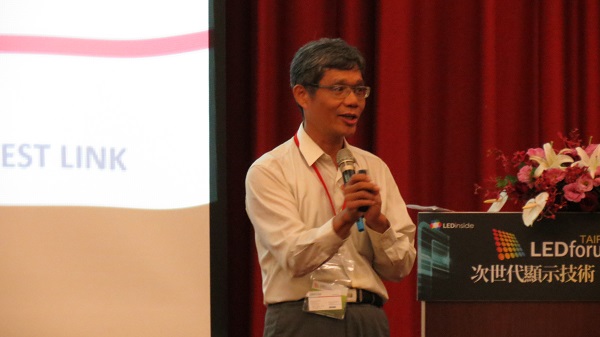(Author: Ivan Lin, Editor-in-Chief, TrendForcehttp://Translator: Judy Lin, Chief Editor, LEDinside)
At LEDforum 2016 hosted by LEDinside in late September in Taipei, Taiwan, industry insiders were all focused on innovative technologies including Quantum Dot (QD), Micro-LEDs and other new technologies. Saturation in the LED backlight market, while the LED lighting market might have high market potential, but requires specialization has ushered development of new applications in the LED industry. Some of these include small-pitch LED displays for billboards, large indoor displays, automotive LEDs, non-visible LED light (UV and IR applications), grow lights and other important emerging applications. Future technology developments include integrating QD technology with micro-LEDs to optimize LED performance.
LEDinside interviewed Carson Hsieh (Min Hsin Hsieh) the Vice President of R&D Center of Epistar, a top Taiwanese LED epiwafer manufacturer, about the LED chip technology trends, and future commercialization possibilities.
Epistar possesses a lot of specialty lighting technologies in the LED industry, and is developing solutions to help solve clients’ issues, said Hsieh.
LEDinside forecasts from 2016 to 2021, the LED industry’s CAGR will reach 2%, based on statistics compiled. This indicates it will be difficult for the industry to achieve soaring growth rates, mainly since mainstream LED applications such as lighting and backlight entered a mature phase, but many niche lighting applications still hold high market potential.
Epistar is optimistic about QD technology applications in LED, and the adoption of CSP LEDs in LCD TV and LED backlight market developments, said Hsieh. The company has been developing QD technology for years, its advanced and mature technology has caught market attention.
 |
|
Carson Hsieh, the Vice President of R&D at Epistar speaking at LEDforum 2016. (LEDinside) |
QD technology advances small-pitch LED displays
Epistar’s advantages in LEDs for display applications include its strong patent portfolio and production capacity of red LEDs (AlInGaP LEDs) that are supplied to RGB LEDs for display applications, and its visibility and high market shares in the small pitch display markets. All these have relied highly on miniaturization of LED chips, effective processing of costs and uniformity of LED chips. Epistar has been introducing QD technology in its small pitch LED displays to improve its color performance, and raise its luminous efficiency.
In LED display applications, especially in LED billboards, indoor displays, and outdoor displays, and semi-outdoor displays that are mainly used for commercial spaces and applications. These are used to broadcast advertisements in public spaces, displaying advertisement posters. In the past, low end LED displays with large pitch distances, low resolutions for indoor displays, and used few LEDs had the greatest market share.
Advancements in LED chip and package technology on the market has led to miniaturizing LED chip size. Epistar’s efforts in LED chip manufacturing has been highly recognized in the industry, and effectively reduced the pitch size in LED displays. Hence, small pitch LED displays now have higher resolutions, and viewers can see the significant increase in image resolution that is increasingly attractive for high end market buyers.
“Emergence of smaller LEDs indicates traditional large outdoor displays can be shrunk to smaller indoor display sizes of 100-inch, 60-inch and even smaller specs”, said Hsieh. Some full HD high resolution displays can even reach 4K resolution and above in the future, which provides new options for the display industry.
Compared to other display technologies, small pitch LED displays are self-illuminating, have high brightness, and have excellent color performance. The displays other advantages include its fast refresh rate and easy maintenance, its seamless splicing features has raised its splicing possibility, especially in super large display sector there are still no replacement technologies that can compete against small pitch LED displays. The main applications for these type of technologies include situation rooms, conference rooms, control centers, verandas, and counter displays.
The most common small pitch display spec on the market currently is pitch 1.6 mm and pitch 1.2 mm, which has greatly raised the demands for 1010 LEDs and 0808 LEDs. Benefiting from market demands, manufacturers have been aggressively developing small pitch display products from 2015-2016.
LEDinside estimates mainstream small pitch LED display specs will evolve from pitch 2.5 mm in 2015 to pitch 0.8 by 2020.
Backlight LEDs benefit from new developments in QD and CSP LED
QD technology can be directly applied on CSP LED packaging, and in the near future these type of LEDs have the opportunity to be applied in smartphones, LED backlight, notebooks, and tablet backlight applications to create better CRI. The result is LCDs will use QD enhanced LEDs for backlight sources to deliver brighter and highly saturated colors that are on par with OLEDs, there is even a potential QD LEDs will outshine OLEDs color performance and have lower costs.
CSP LEDs demands have grabbed the market attention in 2016, and Epistar has been able to control its LED yield rates and reliability, and coming up with good end product designs, said Hsieh.
Collaborating with one of its clients, Epistar has solved CSP LED backlight design issues in edge-lit LED displays, which will overall further expand CSP LED demands.












